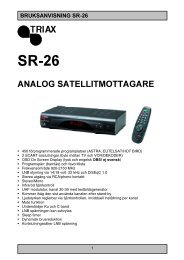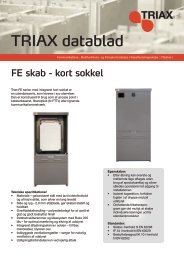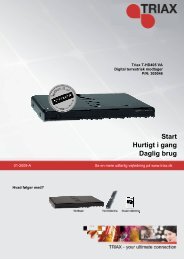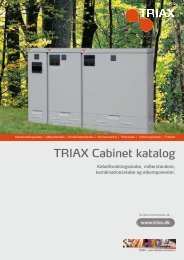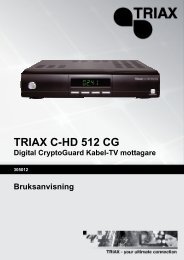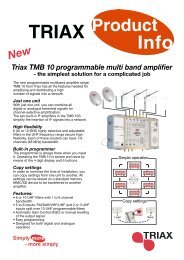TRIAX Multimedia Main Catalogue
TRIAX Multimedia Main Catalogue
TRIAX Multimedia Main Catalogue
Create successful ePaper yourself
Turn your PDF publications into a flip-book with our unique Google optimized e-Paper software.
Technical appendix<br />
2. Technical data in the catalogue<br />
2.1. Characteristic impedance<br />
Unless otherwise expressly mentioned, all technical data in the<br />
catalogue refer to a 75W impedance for the RF connections.<br />
2.2. Operating temperature<br />
All passive units in the catalogue can be used within an<br />
operating temperature range of – 20 °C to + 60 °C.<br />
The mains-operated units meet the requirements of the<br />
EN 60065 standard within the temperature range from – 20 °C<br />
to + 50 °C.<br />
Operability of these units is nevertheless also maintained fully<br />
in the temperature range from –20 °C to + 60 °C.<br />
Individual units that deviate with regard to the above operating<br />
temperature range are specifically mentioned.<br />
2.3. <strong>Main</strong>s voltage<br />
All mains-operated units in the catalogue already meet the<br />
requirements of the IEC 60038 standard, with a rated voltage<br />
of 230 V~ +6% /–10%.<br />
2.4. Wind load<br />
For antenna locations, safety regulations according to<br />
EN 50083-1 differentiate between two heights above ground<br />
(up to 20 m and above 20 m).<br />
They specify different dynamic pressure values for each<br />
height, q = 800 N/m 2 , and q = 1100 N/m 2 respectively.<br />
The wind load values (horizontal and vertical) specified in<br />
this catalogue were determined using a dynamic pressure<br />
of q = 800 N/m2. If a value for q = 1100 N/m2 is needed,<br />
the value in the catalogue has to be multiplied by 1.37.<br />
2.5. Permissible output level for active electronic<br />
equipment<br />
Specification of the permissible output level is made according<br />
to EN 50083-3 “Active broadband equipment for coaxial cable<br />
networks” for a signal-to-noise ratio of:<br />
• IMD = 60 dB for amplifiers for AM, QAM and FM signals<br />
(in SMATV/MATV, broadband cable, CATV installations)<br />
• IMD = 35 dB for amplifiers for FM signals only<br />
(satellite IF transmission)<br />
Now that this measurement method is standard throughout<br />
Europe, this important parameter has become transparent and<br />
comparable. With the aid of this information, the network<br />
planner and installer are able to determine the optimum<br />
amplifier gain (refer also to the planning instructions) to<br />
maintain the required minimum signal-to-noise ratios for a<br />
given number of channels.<br />
This procedure provides considerable advantages wherever<br />
new networks with a minimum number of amplifiers (cost advantage)<br />
are planned or where over riding regulations apply for<br />
certain parts of the network.<br />
For example the permissible output level for a house<br />
connection amplifier to a house connection point is explicitly<br />
specified at CTB/CSO ≥ 66 dB.<br />
This means that the required signal quality (CTB/CSO ≥ 57 dB<br />
according to EN 50083-7) can be maintained up to the subscriber’s<br />
connection. Other permissible output levels are also<br />
given on the one hand for the CENELEC spacing<br />
(EN 50083-3) and on the other hand for full adjacent channel<br />
load of TV bands.<br />
<strong>Main</strong>taining the latter control limits allows for any channel load<br />
with analogue and digital TV signals (worst case: complete<br />
channel load with analogue and digital TV channels).<br />
Assigning only digital TV channels in the frequency range<br />
< 606 MHz makes it possible to raise the output level of the<br />
house connection amplifier by up to 2 dB.<br />
249


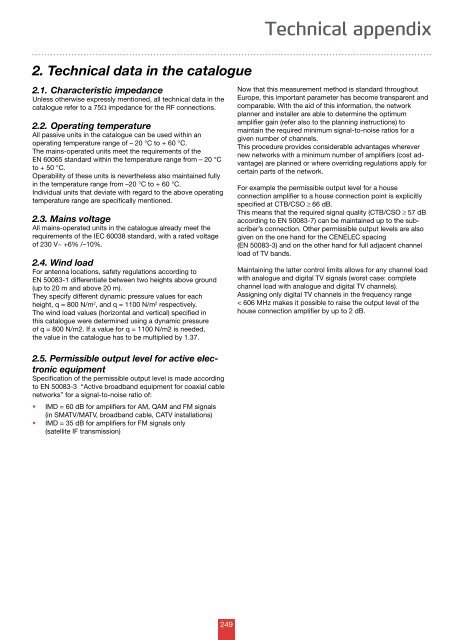

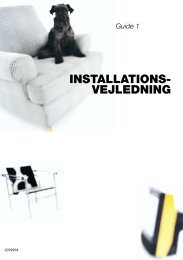
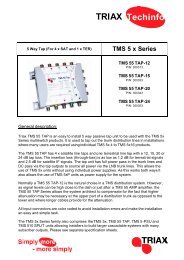

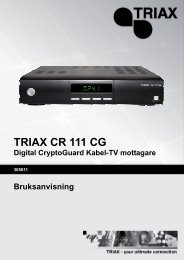
![Triax product info - DVB-C modul TDH [DK - GB].indd](https://img.yumpu.com/48426483/1/184x260/triax-product-info-dvb-c-modul-tdh-dk-gbindd.jpg?quality=85)
